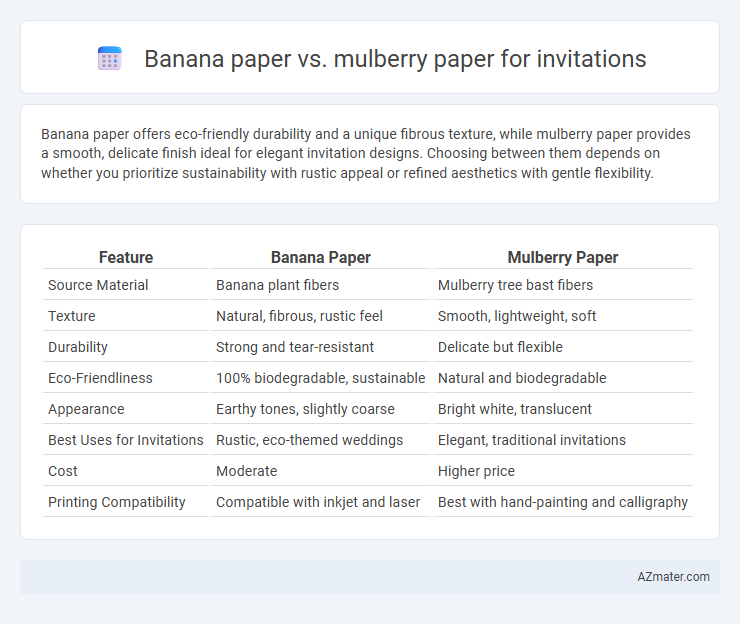Banana paper offers eco-friendly durability and a unique fibrous texture, while mulberry paper provides a smooth, delicate finish ideal for elegant invitation designs. Choosing between them depends on whether you prioritize sustainability with rustic appeal or refined aesthetics with gentle flexibility.
Table of Comparison
| Feature | Banana Paper | Mulberry Paper |
|---|---|---|
| Source Material | Banana plant fibers | Mulberry tree bast fibers |
| Texture | Natural, fibrous, rustic feel | Smooth, lightweight, soft |
| Durability | Strong and tear-resistant | Delicate but flexible |
| Eco-Friendliness | 100% biodegradable, sustainable | Natural and biodegradable |
| Appearance | Earthy tones, slightly coarse | Bright white, translucent |
| Best Uses for Invitations | Rustic, eco-themed weddings | Elegant, traditional invitations |
| Cost | Moderate | Higher price |
| Printing Compatibility | Compatible with inkjet and laser | Best with hand-painting and calligraphy |
Introduction to Eco-Friendly Invitation Papers
Banana paper and mulberry paper are both sustainable choices for eco-friendly invitations, derived from rapidly renewable plant fibers. Banana paper is made from banana plant waste, offering a textured, natural look with high durability and biodegradability. Mulberry paper, sourced from mulberry tree bark, is lightweight, soft, and known for its smooth finish and strength, ideal for elegant, environmentally conscious invitations.
What is Banana Paper?
Banana paper is a sustainable, eco-friendly material made from the fibers of banana plants, known for its durability and unique textured surface ideal for invitations. It offers a natural off-white color with subtle grain variations, enhancing the tactile and visual appeal of event stationery. Compared to mulberry paper, banana paper provides a sturdier feel while maintaining environmental benefits, making it a popular choice for invitations seeking both elegance and sustainability.
What is Mulberry Paper?
Mulberry paper, made from the inner bark of the mulberry tree, is renowned for its soft texture and durability, making it ideal for elegant invitations. Its natural fibers create a lightweight, translucent finish that offers a sophisticated alternative to traditional paper. Compared to banana paper, which is thicker and coarser, mulberry paper provides a delicate and refined aesthetic preferred for high-end event invitations.
Eco-Impact: Sustainability of Banana vs Mulberry Paper
Banana paper, made from agricultural waste such as banana stems, offers a highly sustainable option by utilizing byproducts that would otherwise go to landfill, reducing overall environmental impact. Mulberry paper, derived from the fibers of the Morus alba tree, supports sustainable harvesting practices due to the tree's rapid growth and minimal pesticide use, promoting biodiversity. Both papers provide eco-friendly alternatives for invitations, but banana paper's use of waste materials often results in a lower carbon footprint compared to mulberry paper.
Texture and Appearance: Comparing the Look and Feel
Banana paper offers a distinctive natural texture with visible fibers, providing an organic and rustic appearance ideal for eco-friendly invitations. Mulberry paper features a smooth yet fibrous surface with translucent qualities, lending a delicate and elegant look to formal invitations. The tactile experience of banana paper is coarser and more textured, while mulberry paper is softer and more refined, influencing the overall aesthetic and impression of the invitation.
Printability and Compatibility with Inks
Banana paper offers excellent printability with vibrant ink absorption, making it ideal for both digital and offset printing techniques. Mulberry paper, known for its fibrous texture, may require specialized inks or printing methods to prevent bleeding and ensure clarity. Compatibility with various ink types is higher in banana paper, while mulberry paper demands careful selection of inks for optimal invitation quality.
Durability and Lifespan in Invitations
Banana paper offers exceptional durability due to its strong natural fibers, making it resistant to tearing and suitable for long-lasting invitations. Mulberry paper, while delicate and lightweight, provides moderate durability with a soft texture but may be more prone to wear over time. For invitations that require extended lifespan and resilience, banana paper is a superior choice, balancing eco-friendliness with sturdiness.
Cost Comparison: Banana Paper vs Mulberry Paper
Banana paper typically costs 20-30% less than mulberry paper due to lower raw material expenses and simpler processing techniques. Mulberry paper, made from the durable fibers of the Morus alba tree, commands a premium price reflecting its strength, texture, and traditional handmade methods. For invitations, banana paper offers a budget-friendly option with eco-friendly appeal, while mulberry paper provides a luxurious feel at a higher cost point.
Creative Uses and Design Versatility
Banana paper offers a unique texture and natural fibers that enhance eco-friendly invitations with a rustic, organic appeal, making it ideal for bohemian and nature-inspired designs. Mulberry paper, known for its delicate, lightweight strength and translucent quality, allows intricate detailing and layering, perfect for elegant, intricate invitations. Both papers provide exceptional creative versatility, with banana paper suited for bold, textured aesthetics and mulberry paper excelling in refined, artistic presentations.
Which Paper to Choose for Invitations?
Banana paper offers a unique textured finish and sustainable sourcing from banana plant fibers, making it an eco-friendly choice for invitations that emphasize natural aesthetics. Mulberry paper, crafted from the fibers of the mulberry tree, provides a smoother, more delicate feel with exceptional durability and a luxurious appearance ideal for formal or traditional invitations. Choose banana paper for a rustic, environmentally conscious design and mulberry paper for elegant, high-quality invitations that require a refined texture and longevity.

Infographic: Banana paper vs Mulberry paper for Invitation
 azmater.com
azmater.com